The greatest Big Band players of all time part 2
The key players from the latter day big band and swing era that you must hear

Mel Lewis
Lewis blended the subtlety of small group jazz with the fire and swing of the big band, most notably with the orchestra he co-led with trumpeter Thad Jones. Lewis swung with intensity and depth of feeling that has seldom been equalled and his swing feel remains a benchmark.
Calfskin heads and old, dark, Turkish K Zildjians helped him create his signature sound. Mel was a man of great integrity who stayed true to his musical ideals. A meeting with him in the USA in 1985 changed my direction when, without being asked, he sat down at the drums and demonstrated his unique ride cymbal approach, which I promptly appropriated. The Thad Jones/Mel Lewis Orchestra made its debut in 1966 at the Village Vanguard in NYC, a weekly residency the Vanguard Jazz Orchestra maintains to this day. Also check out Mel’s earlier work with the Terry Gibbs Dream Band.
Key tracks: Presenting the Thad Jones/Mel Lewis Orchestra, ‘Mean What You Say’; Thad Jones & Mel Lewis, ‘Cherry Juice’ (New Life); ‘Blues in a Minute’, (Potpourri)
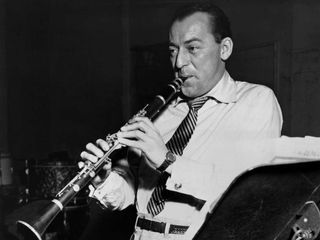
Jake Hanna (1931-2010)
The powerhouse drummer who fired up Woody Herman’s Herd in the early- to mid-’60s – check out the Jazz 625 TV show on YouTube.
A swinging and driving player who had a level of versatility comparable to Mel Lewis in that he was at home with any combination from a trio to a big band, and whilst a more than capable soloist, he eschewed chops of any kind, in later years playing a two-piece kit with a couple of rides. Jake spent many years in the LA studio scene and in his later career played jazz with small groups. To spend time in Jake’s company was a pleasure, he was a great musician and a huge personality, on stage and off.
Key tracks: Woody Herman ‘Hallelujah Time’ (Live In ’64); ‘Better Get it in Your Soul’, (Encore); ‘Apple Honey’, (Woody’s Big Band Goodies)
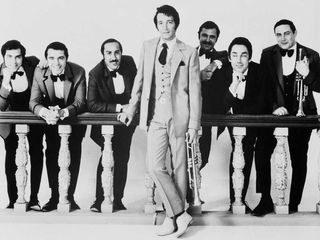
Nick Ceroli (1939-1985)
Ceroli first came to public attention as the ‘live’ drummer with Herb Alpert And The Tijuana Brass. Ceroli was a constant presence on US TV for many years as the drummer in the house band on the Merv Griffin Show.
More importantly he maintained an active role on the jazz and big band scene in California. There are terrific small band jazz recordings featuring Ceroli with saxophonists Art Pepper (Collections) and Pete Christlieb (Live At Dino’s). His trademark in the big band rhythm section was his china, known as ‘the trash can’. You can hear him at his swinging best on four standout albums with Bob Florence’s big band. He passed away in 1985 at just 45 years of age.
Key tracks: Bob Florence Limited Edition, ‘Nobody’s Human’ (Soaring); ‘Rhythm And Blues’ (Magic Time); Bob Florence Big Band, ‘Carmelo’s By The Freeway’ (Westlake)
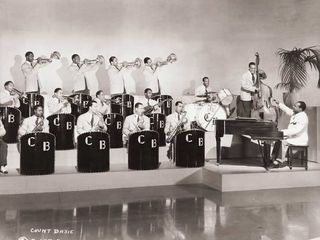
Sonny Payne (1926-1979)
Of all the great drummers of the ‘new testament’ Count Basie band, Payne was a driving, swinging, technically gifted player with few equals. He is often best remembered for his showmanship and stick tricks, but we shouldn’t be diverted from the ineluctable fact that he was a true master of the big band style.
Check out the entire Atomic Mr Basie album and see how musical and understated he could be. The Basie band’s studio collaborations with Frank Sinatra are masterpieces too, although on the seminal Sinatra At The Sands recording there are times Sonny strays dangerously close to overplaying territory. One of the outstanding key elements of his style was his ability to make dramatic changes in dynamics in four or eight-bar fills and really control the volume of the ensemble. That he was first choice as a permanent replacement when Buddy Rich left Harry James’ band in 1966 shows the esteem in which he was rightly held.
Key tracks: Count Basie, ‘Fantail’, (The Atomic Mr Basie); ‘Half Moon Street’ (Chairman Of The Board); ‘Counter Block’ (Breakfast Dance and Barbecue)
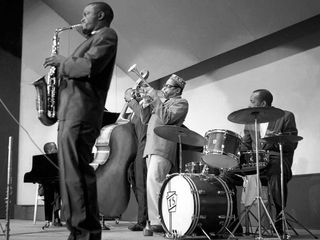
Charlie Persip (1929-)
One of the few true giants still with us today, I first was introduced to Persip’s work at a very early age courtesy of a drum compilation vinyl LP. Immediately I was captivated by his sound and style, he was speaking the be bop language of Max Roach and Philly Joe Jones but combining it with speed, chops and stamina to rival Buddy Rich.
He had an amazing bass pedal technique and was able to achieve speed that many of his contemporaries required two bass drums to equal. Although attaining prominence via his work with Dizzy Gillespie’s big band between 1955 and ’58 he managed to avoid typecasting as ‘just a big band drummer’ and recorded in small groups with a wide ranging and distinguished assortment of jazz stars. A bandleader in his own right, Persip’s recordings with his own large and small groups are worth seeking out.
Key tracks: Dizzy Gillespie, ‘The Champ’, (World Statesman); Charlie Persip, ‘The Song is You’ (Charles Persip And The Jazz Statesmen); Various, ‘Drum Solo’ (Gretsch Drum Night at Birdland)
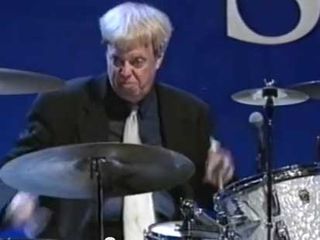
Butch Miles (1944-)
I owe Butch Miles an enormous debt of gratitude. Of all the drummers who managed to get remotely close to Buddy Rich in the ability stakes (and there haven’t been more than a handful in music history) Butch Miles was the first I saw and heard, and his playing was a huge inspiration.
He fired up the mid-1970s Count Basie band with a hard-driving swing that lifted the ensemble and inspired some of the greatest musical achievements of its later years. Butch’s fallings out with Buddy have been widely documented but it is less well known that Buddy recommended him for the Basie gig in the first place. A non-stop swinger in bands both large and small Butch was also a member of the Dave Brubeck Quartet for a period and remains active to this day.
Top tracks: Count Basie, ‘The Heat’s On’, Montreux ’77; ‘Ya Gotta Try’, Prime Time; Count Basie Orchestra ‘Drum Thing’, Swing Shift
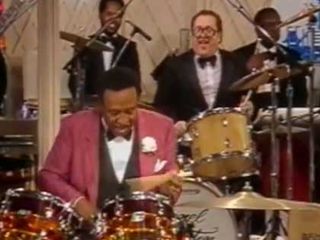
Duffy Jackson (1953-)
Butch Miles’s successor in the Basie band, Duffy Jackson stands out as one of the most swinging and utterly exuberant big band drummers of more recent times. Being the son of Woody Herman bass player Chubby Jackson, Duffy’s rhythmic credentials were established from an early age. His father’s close working relationship with Dave Tough and Don Lamond certainly stood him in good stead.
For me it is his work with vibes legend Lionel Hampton as well as recordings as a leader in his own right that showcase his compelling swing to best effect. Particularly noteworthy is a Hampton recording in Japan, which has some of the most driving and yet swinging (qualities that sometimes do not go hand in hand) ride work you will ever hear.
Top tracks: Lionel Hampton ‘Minor Thesis’ & ‘Valve Job’, Made In Japan; Duffy Jackson ‘Haemoglobin’, Swing Swing Swing

Peter Erskine (1954-)
One of the most significant jazz musicians of the past quarter-century, Erskine was holding down the drum chair with the Stan Kenton Orchestra when he was just 18. His maturity on the recordings from this period is simply startling.
For many years the recordings Erskine made with Jaco Pastorius have rightly been considered to be amongst the most significant latter day big band music, but for me it is his work on Bob Mintzer’s superb 1980s big band albums that stand out. Erskine’s drumming is the perfect foil for Mintzer’s writing, which for my money ranks among the most well-crafted big band compositions of recent years. One of the most musically aware, sensitive, listening drummers you will ever hear in a big band rhythm section. This made him the only viable choice when trumpet player/composer Kenny Wheeler recorded his seminal Music For Large and Small Ensembles in 1990.
Top tracks: Stan Kenton Orchestra ‘Pete is a Four Letter Word’, Fire Fury and Fun; Jaco Pastorius Big Band ‘Liberty City’, Twins Live In Japan 1982; Bob Mintzer Big Band ‘In the Eighties’, Camouflage

John Riley (1954-)
Known to drummers the world over for his hugely successful and influential books on jazz drumming in small group contexts, John Riley is one of the great big band drummers active today. He occupies Mel Lewis’s former Monday night hot seat with the Vanguard Jazz Orchestra at New York City’s legendary Village Vanguard club, where I have been fortunate enough to hear him at close quarters.
A musical and swinging player he is also highly adept technically but uses this facility solely for the good of the music, and his seemingly effortless extreme up-tempo ride cymbal work is a masterclass in exactly how it should be done. A great player and a great educator as well, his knowledge of the history of jazz drumming is nothing short of encyclopaedic.
Top tracks: Bob Mintzer Big Band ‘Treasure Hunt’, Only in New York; Vanguard Jazz Orchestra ‘Once Around’, Thad Jones Legacy; Vanguard Jazz Orchestra ‘Mel’, Lickety Split
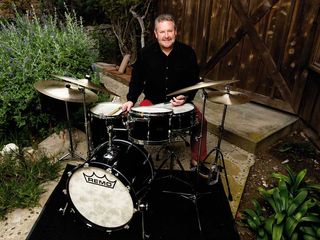
Jeff Hamilton (1953-)
One of the most popular, successful and in demand big band drummers of recent times, Jeff Hamilton first came to my attention on Woody Herman’s 1978 recording Road Father. His swing concept immediately stood out as being the perfect mix of laid back swing and forward motion, to the point where he managed to make ‘Woodchopper’s Ball’ (Herman’s 1930s signature blues riff) sound interesting.
In many respects Hamilton is a modern day Shelley Manne or Mel Lewis. Completely at home in settings from a trio upwards his style seems to suit any size of band without any need for modification or adaptation and his playing remains consistent and identifiable in whatever context you hear him. For me it his work in the big band he co-leads with brothers John and Jeff Clayton which best exemplifies his style and class in the big band driver’s seat.
Top tracks: Clayton Hamilton Jazz Orchestra ‘I Be Serious About Dem Blues’, Heart and Soul; ‘Eternal Triangle’, Live at MCG; ‘Max’, Shout Me Out
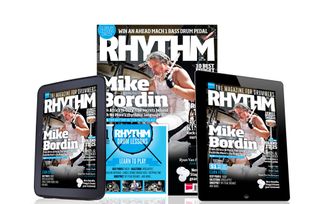
Beginner's Guide to Big Band Drumming
Pete Cater concludes his four-part guide to Big Band Drumming only in this month’s Rhythm. You can still get parts 1-3 here!
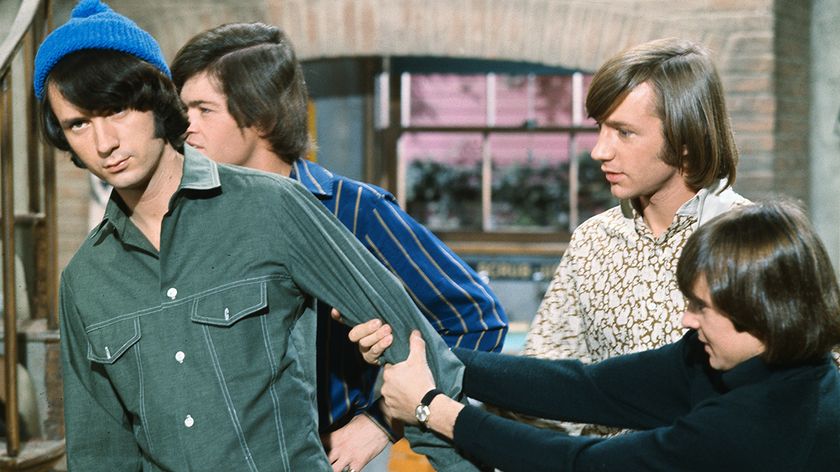
"They said, ‘Thank you, but no thank you - it’s not a Monkees song.’ He said, ‘Wait a minute, I am one of the Monkees! What are you talking about?’": Micky Dolenz explains Mike Nesmith's "frustration" at being in The Monkees

“There’s nights where I think, ‘If we don’t get to Paradise City soon I’m going to pass out!’”: How drummer Frank Ferrer powered Guns N’ Roses for 19 years

"They said, ‘Thank you, but no thank you - it’s not a Monkees song.’ He said, ‘Wait a minute, I am one of the Monkees! What are you talking about?’": Micky Dolenz explains Mike Nesmith's "frustration" at being in The Monkees

“There’s nights where I think, ‘If we don’t get to Paradise City soon I’m going to pass out!’”: How drummer Frank Ferrer powered Guns N’ Roses for 19 years









